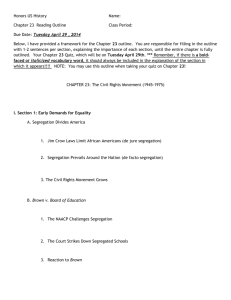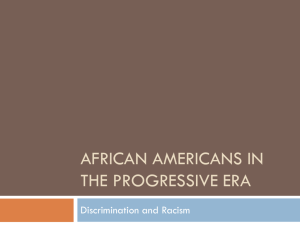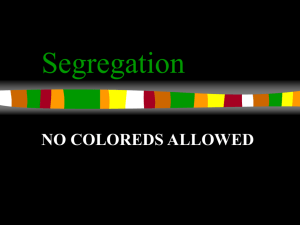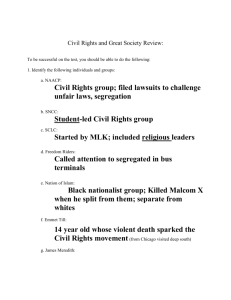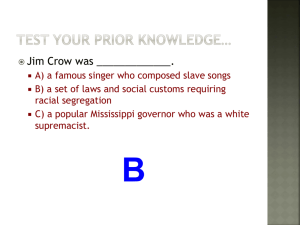Lesson Plan - CivilRightsPBL
advertisement
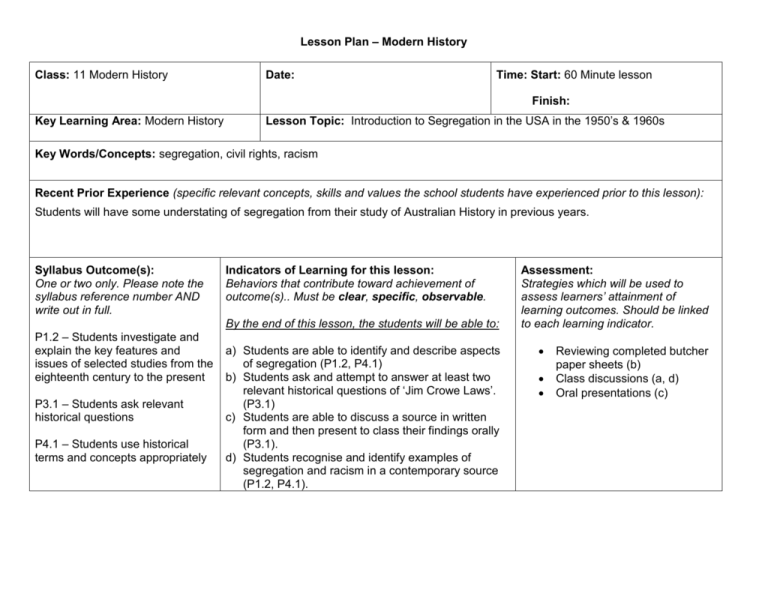
Lesson Plan – Modern History Class: 11 Modern History Date: Time: Start: 60 Minute lesson Finish: Key Learning Area: Modern History Lesson Topic: Introduction to Segregation in the USA in the 1950’s & 1960s Key Words/Concepts: segregation, civil rights, racism Recent Prior Experience (specific relevant concepts, skills and values the school students have experienced prior to this lesson): Students will have some understating of segregation from their study of Australian History in previous years. Syllabus Outcome(s): One or two only. Please note the syllabus reference number AND write out in full. Indicators of Learning for this lesson: Behaviors that contribute toward achievement of outcome(s).. Must be clear, specific, observable. By the end of this lesson, the students will be able to: P1.2 – Students investigate and explain the key features and issues of selected studies from the eighteenth century to the present P3.1 – Students ask relevant historical questions P4.1 – Students use historical terms and concepts appropriately a) Students are able to identify and describe aspects of segregation (P1.2, P4.1) b) Students ask and attempt to answer at least two relevant historical questions of ‘Jim Crowe Laws’. (P3.1) c) Students are able to discuss a source in written form and then present to class their findings orally (P3.1). d) Students recognise and identify examples of segregation and racism in a contemporary source (P1.2, P4.1). Assessment: Strategies which will be used to assess learners’ attainment of learning outcomes. Should be linked to each learning indicator. Reviewing completed butcher paper sheets (b) Class discussions (a, d) Oral presentations (c) Any safety issues to be considered: Ensure laptop and projector cords are set up safely. Resources: List resources used in preparing the lesson AND those used in the lesson implementation. Board of Studies NSW (2009) Modern History Stage 6 Syllabus Facing History and Ourselves (2010) Big Paper – Building a Silent Conversation http://www.facinghistory.org/resources/strategies/big-paper-building-a-silent-c Black Stars Laptop Projector Whiteboard Markers Hairspray (2007), Adam Shankman “Jim Crow Laws” handout - http://www.sju.edu/~brokes/jimcrow.htm Butcher’s Paper LESSON SEQUENCE Lesson Content / Indicators of Learning (What is Taught): Timing (mins) Teaching Strategies / Learning Experiences: (How it is taught) Resources and Organisation: INTRODUCTION Introduction to segregation 5 mins Empathy Task: As students enter the room teacher gives half the class a black star and asks all students with black stars to sit on one side of the room. (Throughout lesson, Teacher does not allow the students to mix or communicate with the other side of the room. Teacher acts more dismissive of students with stars and gives less encouragement etc.) Black Stars Teacher plays segment of “Hairspray”, that demonstrates segregation to students. Laptop, Projector, “Hairspray” DVD Students watch segment. DEVELOPMENT What is Segregation? 10 mins Discussion: Teacher asks students to describe what elements of segregation they see and what other understandings they already have of segregation. Whiteboard, markers Teacher details student responses in a mind map. Students copy mind map into books. What was segregation like in 5 mins the USA? Cooperative Learning: Teacher gives handouts of “Jim “Jim Crow Laws” Handout Crow Laws” and asks students to form groups of three – Students can only form groups with people from their side of the room. Each group has a different set of laws. 20 Big Paper – Building a Silent Conversation: Teacher Butcher’s paper, markers minutes gives each group a piece of butcher’s paper and each student a different coloured marker. Students are to comment on the “Jim Crow Laws”, and ask questions of each other in writing on the Big Paper – No verbal conversation is to take place. Students as a group present to the class 2 main comments/questions they found from the text. 10 minutes Students make note of comments/questions their group didn’t come up with. CLOSURE Conclusion of Empathy Task: 10 mins Teacher uses questioning to identify if there was any differences to the lesson that students noticed. Students identify aspects of segregation that they noticed throughout the lesson. Teacher has students write a one-page reflection on segregation and how they felt on either side of it. HW: Students research a definition for segregation and racism.

